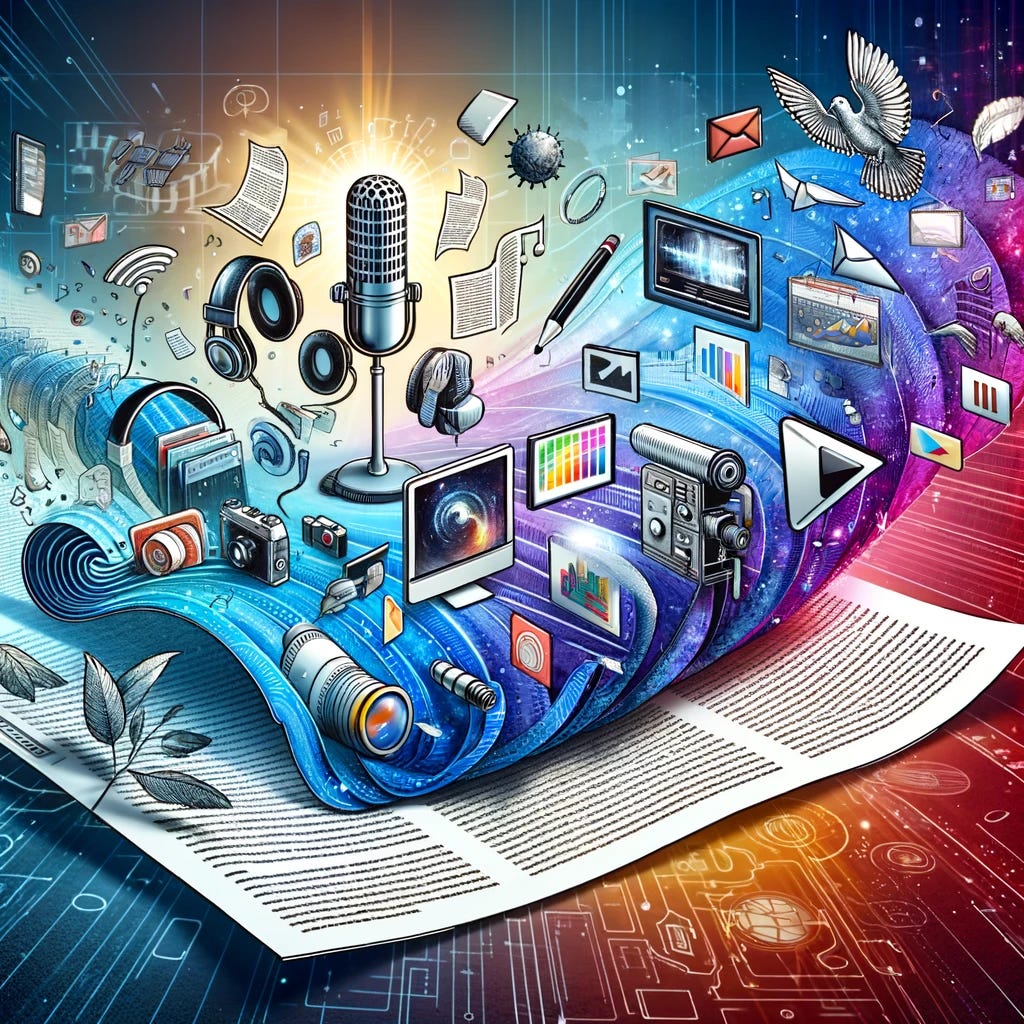A Possible Future for Online Content
Reimagining Content Creation and Consumption with Generative AI
I was recently asked how I would build a news agency from scratch if I were to start today, taking full advantage of the potential that generative AI has in revolutionizing the industry.
While I won’t pretend to be an expert in the news industry - I do have a well informed point of view on how to think about generative AI and the potential it has to change products and experiences. Thinking about this through the lens of a news organization, I can’t help but feel that the changes could be vast, impacting both content creation and consumption. Here's my quick take on what I would be considering when it comes to rebuilding the product strategy from the ground up, putting generative AI at the center:
1. Streamlining Sourcing and Writing:
Effortless Research: Imagine a tool that makes aggregating information from various sources seamless - quickly pulling in voice memos, video clips, photos, user testimonials…anything and everything - then it’s able to extract relevant facts from these sources, highlighting unique perspectives for a potential story. This would empower journalists to quickly comb through every possible source and modality, discovering relevant context and nuances that could resonate best with their audience, saving precious time and effort while turning those into a story.
Enhanced Writing: Once all the information has been pulled together, Generative AI can then assist in drafting different versions of a story, catering to various audience segments and platforms. From concise summaries to in-depth analyses, the technology can adapt the writing style and tone to resonate with specific readers/listeners/viewers. Furthermore, the generated content can be created in a style that reflects the unique and personalized tone of each author.
The key here is that AI wouldn’t replace the job of the writer, but rather augment their workflows to not only make them easier and faster, but also produce better content for the readers.
2. Creative Content Remixing:
Multi-Platform Distribution: Once your content is created, generative AI can help you tailor it for various platforms and formats. A long-form article could be transformed into a short video for YouTube or TikTok, an infographic for Instagram, or a concise summary for LinkedIn. This allows you to quickly and easily reach a wider audience and cater to different consumption preferences all starting from the same source material.
Personalized Content Experiences: Imagine news articles that can be instantly converted into audio for listening when you’re on a walk, or turned into videos with accompanying graphics if you’re a visual learner. Generative AI can personalize the content experience by adapting to user preferences and learning over time. This could include summarizing key points, providing alternative explanations, or even generating quizzes to test comprehension.
The idea here is that a single source of content can be turned into any medium quickly and easily, allowing you to quickly distribute it across any medium or platform.
3. User Specific Content:
Intelligent Content Delivery: Forget generic news feeds. Generative AI can analyze user behavior and preferences to deliver highly relevant content at the right time and through the preferred channels. Imagine receiving breaking news alerts based on your interests, or having your daily news digest customized to your specific areas of focus. While the idea of personalization isn’t a new one - I think the ease at which we’ll actually be able to live up to this hype is going to mean it will become an even more integral aspect of how to “put the user first”.
More Relevant Recommendations: Generative AI can facilitate deeper engagement with content. Users could ask questions about the content, request different perspectives, or even explore related topics through AI-powered recommendations. This can lead to longer engagements and deeper and more meaningful interactions.
The takeaway here is that content delivery will be reimagined by generative AI's ability to personalize the user experience enabling the tailoring of information and recommendations, ultimately fostering deeper engagement and satisfaction.
4. Understanding User Goals:
Beyond Content Consumption: If you understand your users’ goals, you can better tailor their experience. Generative AI can help with both. First, it can assist with analyzing and understanding user behavior to help figure out what your users want - are they looking for work-related insights, exploring personal interests, or simply staying informed on current events? Secondly, it can take this understanding and help you to tailor the content experience, even suggesting relevant actions such as connecting with experts, joining online communities, or exploring educational resources.
The Future is Flexible and Fluid:
Ultimately, the goal here is to foster a more fluid and flexible content ecosystem. Capturing ideas on the fly through voice memos, images, or scribbled notes, and then using AI to transform them into polished articles. This both unlocks your creativity and also streamlines the writing process, allowing journalists to focus on the core of their work: insightful storytelling from a human perspective.
Generative AI is not just about automating tasks; it's about augmenting human capabilities and creating a more personalized, engaging, and informative news experience. By embracing this technology, news companies can not only adapt to the evolving media landscape but also pioneer a new era of content creation and consumption.



